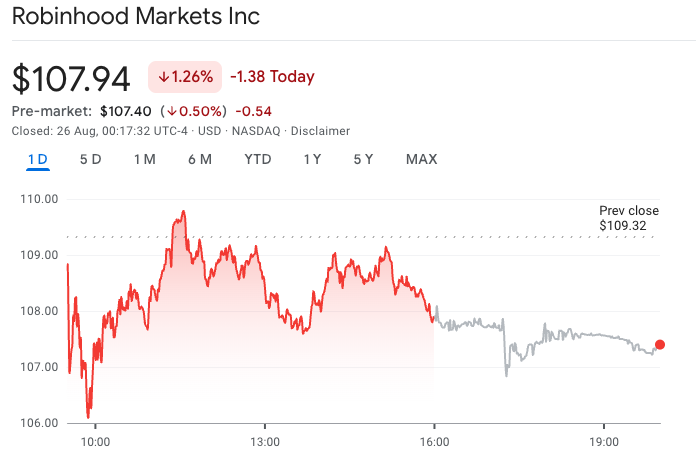Robinhood was again excluded from S&P 500 inclusion, with Interactive Brokers chosen instead, causing Robinhood and MicroStrategy shares to dip. S&P inclusion decisions are committee-driven and depend on market cap, US listing, liquidity and other criteria, not solely recent price gains.
-
Robinhood missed S&P 500 inclusion despite strong year-to-date gains
-
Interactive Brokers will replace Walgreens Boots Alliance in the S&P 500 at the next market open.
-
MicroStrategy shares fell alongside Bitcoin after the S&P decision; inclusion depends on market-cap and liquidity rules.
Robinhood S&P 500: Robinhood excluded again from S&P 500; shares dip — learn what drives inclusion and market impacts. Read the full analysis now.
What happened when Robinhood missed S&P 500 inclusion?
Robinhood S&P 500 inclusion was once again passed over in favor of Interactive Brokers Group, prompting modest after-hours declines in Robinhood (HOOD) and sharper moves in MicroStrategy (MSTR). The S&P decision is made by a committee that prioritizes market-cap thresholds, US listing and liquidity over short-term price momentum.
How did markets react to the S&P committee’s choice?
Robinhood shares fell about 0.5% in after-hours trading to $107.40 after a 1.26% intraday decline. Interactive Brokers (IBKR) rose roughly 3.9% in extended trading on the announcement. MicroStrategy, which has significant Bitcoin holdings, ended the day down 4.17% and slipped further in after-hours trading as BTC briefly dipped below $110,000.
How does S&P 500 inclusion work?
Inclusion in the S&P 500 is a committee decision guided by clear criteria: a minimum market capitalization (currently $22.7 billion), US domicile, listing on NYSE/Nasdaq/Cboe, and minimum liquidity and share volume requirements. The committee also considers sector representation and corporate actions when rebalancing the index.
Why does inclusion matter for stocks?
Being added to the S&P 500 typically increases demand from passive index funds and ETFs, boosting a stock’s liquidity and potentially its price. Institutional index-tracking flows can be significant immediately after inclusion, which is why market participants closely monitor rebalancing announcements from S&P Dow Jones Indices.
Robinhood again snubbed from S&P 500 — what’s the context?
Wall Street expected Robinhood to be a strong candidate after robust YTD gains (nearly 190% this year). However, index selection considers more than momentum. Interactive Brokers met the committee’s mix of size, liquidity and fit for the index in the latest rebalance, replacing Walgreens Boots Alliance when markets open on Thursday.
Shares in Robinhood had previously dipped in early June when S&P Dow Jones Indices announced no changes to the S&P 500 during that quarterly rebalance. Despite the snub, Robinhood’s stock has recorded substantial gains in 2025 due to renewed retail investor interest.

Source: Google Finance
How did MicroStrategy respond to the S&P decision and Bitcoin moves?
MicroStrategy (MSTR) shares fell after the announcement and as Bitcoin sold off roughly 2% over the prior 24 hours. Because MicroStrategy’s market capitalization is influenced heavily by its BTC holdings, swings in Bitcoin’s price can affect its S&P eligibility and share performance.
What criteria made Interactive Brokers the choice?
Interactive Brokers met the committee’s size and liquidity benchmarks and offered a sector fit for the S&P 500’s composition. The committee balances objective thresholds with discretion, weighing factors such as ownership structure and trading volume.
Frequently Asked Questions
Did Robinhood’s strong YTD gains not matter for S&P inclusion?
While Robinhood’s stock has climbed nearly 190% this year, the S&P committee prioritizes market-cap thresholds, liquidity and index composition over recent momentum when selecting additions.
What triggers immediate stock moves on inclusion announcements?
Passive funds and ETFs that track the S&P 500 must buy added constituents, creating near-term demand. Market expectations and programmatic rebalancing drive immediate price reactions.
Key Takeaways
- Committee decision matters: S&P inclusion is determined by objective criteria and committee discretion, not just price moves.
- Market impact is real: Inclusion or exclusion can prompt rapid flows from index funds and affect liquidity.
- Crypto exposure affects eligibility: Firms like MicroStrategy, exposed to Bitcoin, see their market-cap and volatility tied to BTC price movements.
Conclusion
Robinhood’s exclusion from the S&P 500 underscores that committee criteria — market cap, US listing and liquidity — drive index changes, not short-term rallies. Investors should monitor official S&P Dow Jones Indices announcements and corporate filings for the most reliable signals. COINOTAG will continue tracking implications for Robinhood, MicroStrategy and market flows.
